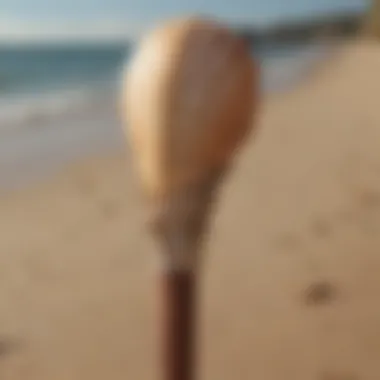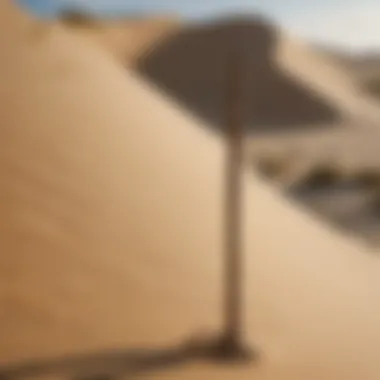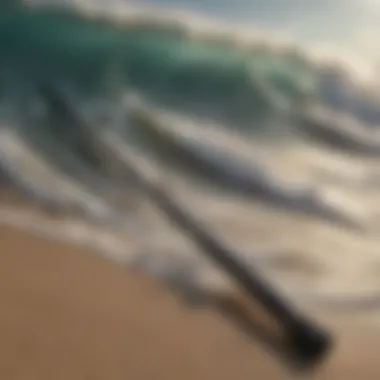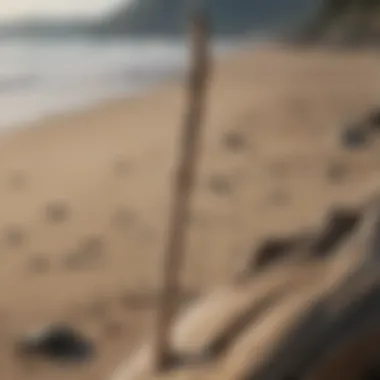Expert Guide to Selecting the Perfect Beach Walking Stick


Rock and Fossil Identification
When it comes to selecting the ideal walking stick for beach adventures, it is crucial to consider various key factors that will significantly impact your comfort and stability during seaside strolls. The type of walking stick you choose can make a substantial difference in your overall experience, enhancing both functionality and ease of movement on beach terrain. Understanding the characteristics of different walking sticks, such as material, weight, and grip, is essential in making an informed decision.
Collecting Tips and Techniques
In the quest for the perfect beach companion, knowing the best practices for collecting rocks and fossils is invaluable. Exploring prime collecting sites along the shore can lead to exciting discoveries, but it is essential to do so safely and responsibly. Utilizing the right tools and techniques to extract specimens without causing damage is crucial to preserving the natural beauty of beach treasures.
Preservation and Display
Once you've gathered your coveted rocks and fossils, knowing how to preserve them effectively is key to maintaining their integrity and appeal. Employing proper preservation techniques and storage methods can prolong the lifespan of your collection. Additionally, considering creative ways to display your beach treasures can turn your finds into captivating works of art that add a touch of natural beauty to any space.
Geological Insights
Delving deeper into the geological aspects of beach terrain can provide valuable insights into the formations and processes that have shaped these coastal landscapes. Understanding the historical significance of rocks and fossils found along the shore can offer a glimpse into the fascinating stories they hold. Exploring notable discoveries in the field of geology can enrich your beach adventures with a deeper appreciation for the natural world around you.
Introduction
Walking sticks, often associated with forest hikes and mountain treks, are also indispensable companions for beach adventures. As we embark on sandy shores, these humble yet versatile tools offer a plethora of benefits that can elevate our seaside experience. Through enhanced stability, they become steadfast allies in navigating the shifting sands and uneven coastal terrain. Moreover, by reducing strain on our joints, walking sticks provide us with the freedom to explore for longer durations without succumbing to physical discomfort. Whether facing uphill climbs or meandering through challenging landscapes, the assistance provided by a reliable walking stick at the beach is unparalleled. In this guide to selecting the best walking stick for beach use, we delve into key factors that must be considered to ensure optimum comfort, stability, and functionality during relaxing strolls or invigorating beach walks. By taking the time to choose the right walking stick tailored specifically for beach terrain, individuals can significantly enhance their seaside sojourns and make lasting memories amidst the calming rhythm of the ocean waves.
Benefits of Using a Walking Stick at the Beach


In the realm of beach adventures, a walking stick proves to be a reliable companion, offering a plethora of advantages for enthusiasts. When meandering along the sandy shores, one prominent benefit is the enhanced stability that a walking stick provides. By serving as an additional point of contact with the ground, it significantly reduces the risk of slipping or stumbling on uneven surfaces. This added stability not only promotes a sense of security but also instills confidence in beach explorers, enabling them to traverse the terrain with ease and grace.
Enhanced Stability
The concept of stability encompasses a paramount role in the realm of beach activities. With the constantly shifting sands and varying inclines at the shore, individuals can benefit greatly from the improved balance offered by a walking stick. By having an extra point of support, users can navigate through challenging beach terrains with greater steadiness and poise. This enhanced stability is not only essential for preventing falls or injuries but also contributes to a more relaxed and enjoyable seaside experience.
Reduced Strain on Joints
Another significant advantage of utilizing a walking stick at the beach is the notable reduction in strain on joints. Walking on soft, uneven surfaces like sand can exert additional pressure on the knees, ankles, and hips, potentially leading to discomfort or pain. By redistributing some of the body's weight onto the walking stick, individuals can alleviate the strain on their joints, thus minimizing the risk of overuse injuries or fatigue. This adjustment in weight distribution promotes a more ergonomic walking posture, fostering a sustainable beach excursion for walkers of all ages.
Assistance in Uphill and Uneven Terrain
When faced with uphill climbs or uneven beach pathways, a walking stick emerges as a valuable tool for assistance. By providing an extra point of contact with the ground, it aids in tackling inclines more effectively and eases the strain on leg muscles. The added support from the walking stick not only enhances propulsion uphill but also offers stability on irregular surfaces, ensuring a smoother and safer journey. This assistance proves particularly beneficial for individuals with mobility challenges or those seeking to conquer more demanding beach routes.
Factors to Consider When Choosing a Walking Stick for the Beach
When selecting a walking stick for beach use, several crucial factors must be taken into consideration to ensure optimal performance and safety. The choice of walking stick plays a significant role in enhancing one's beach experience. It is not merely a matter of aesthetics but more importantly, functionality and comfort that will impact the overall enjoyment of seaside strolls.
Material and Durability
The material composition of a walking stick is of utmost importance when considering its suitability for beach terrain. Given the abrasive nature of sand and the exposure to salty sea air, a durable and corrosion-resistant material is essential. Materials like high-grade aluminum or carbon fiber are popular choices for beach-friendly walking sticks due to their lightweight yet sturdy properties. These materials ensure that the walking stick can withstand the harsh coastal environment without compromising on performance or longevity.
Adjustability for Height


Another crucial factor to consider when choosing a walking stick for the beach is its adjustability for height. Beach terrain can vary significantly, with slopes and uneven surfaces that require different handle heights for optimal comfort and stability. An adjustable walking stick allows users to customize the height according to their preference, ensuring proper alignment with their body posture and walking comfort. This feature is particularly beneficial for individuals of varying heights or those who may want to share the walking stick with others.
Grip Design for Wet Conditions
The grip design of a walking stick becomes paramount when considering its usability in wet conditions typically encountered at the beach. A non-slip and ergonomic grip is essential to prevent accidents or discomfort caused by sweaty hands or wet surfaces. Look for walking sticks with rubberized or textured grips that offer a secure hold even when exposed to moisture. Enhanced grip design ensures that the walking stick remains firmly in hand, providing stability and confidence while navigating sandy or wet beach terrain.
Types of Walking Sticks Suitable for Beach Use
In this section, we delve into the significance of choosing the right walking stick for beach use. When contemplating the best walking stick for beach adventures, several essential factors must be considered to ensure optimal performance. The type of walking stick plays a pivotal role in determining comfort, stability, and overall functionality while navigating sandy shores and coastal terrains. By understanding the distinct features and benefits of various walking stick types tailored for beach use, individuals can make informed decisions that enhance their seaside experience.
Telescopic Walking Sticks
Telescopic walking sticks are versatile tools ideal for beach treks due to their adjustable length feature, which allows users to customize the stick according to their height and preference. These walking sticks can be easily extended or retracted to suit different terrains and walking conditions, making them highly adaptable for beach environments. The telescopic design ensures compactness for convenient transportation and storage, making them a practical choice for beachgoers seeking versatility and ease of use.
Folding Walking Sticks
Folding walking sticks offer a convenient solution for beachgoers looking for compact and portable walking aids. These sticks can be easily folded into a compact size, making them effortless to transport and store when not in use. The collapsible nature of folding walking sticks enables users to adjust the stick to their desired height, providing personalized comfort during beach strolls. Their lightweight construction adds to their appeal, offering a balance between functionality and portability for individuals seeking a practical walking companion for beach adventures.
Shock-Absorbing Walking Sticks
Shock-absorbing walking sticks are designed to reduce impact and strain on joints while walking on uneven or challenging terrains, making them an excellent choice for beach use. The innovative shock-absorbing technology integrated into these walking sticks helps minimize vibrations and jolts, promoting a smoother walking experience on sandy beaches or rocky coastlines. By providing enhanced cushioning and support, shock-absorbing walking sticks help alleviate pressure on joints, enabling beach enthusiasts to leisurely stroll along the shorelines with added comfort and stability.
Recommended Features for Beach-Friendly Walking Sticks


Choosing a walking stick optimized for beach use is a critical decision to ensure a comfortable and stable seaside experience. One key aspect to consider when selecting the best walking stick for beach adventures is its recommended features tailored for enhancing functionality in sandy and wet conditions. These features play a vital role in providing the necessary support and security required for safe and enjoyable strolls along the beachfront.
Lightweight Construction
The lightweight construction of a beach-friendly walking stick is paramount for ease of use and portability during beach outings. Opting for a walking stick crafted from lightweight materials such as aluminum or carbon fiber reduces strain on the arms while ensuring a nimble and effortless walking experience. Additionally, a lightweight walking stick allows for prolonged use without causing fatigue, letting you enjoy long walks on the beach without feeling weighed down.
Wrist Straps for Security
Wrist straps serve as a crucial safety feature for beach-friendly walking sticks, providing added security and stability while trekking through sandy terrain. By securing your hand with a wrist strap, you prevent accidental drops or slips, allowing for a secure grip even in challenging beach conditions. Wrist straps also offer ergonomic benefits by distributing the pressure evenly across your hand and wrist, reducing strain and enhancing comfort during extended walks on the beach.
Rubber Tips for Enhanced Traction
Rubber tips are essential components of beach-friendly walking sticks, contributing significantly to improved traction and stability on sandy and slippery surfaces. The rubber tips grip the sand firmly, preventing slips or skids, especially on wet or uneven beach terrain. Additionally, rubber tips are durable and long-lasting, providing reliable support and traction for numerous beach excursions. Enhancing your walking stick with rubber tips ensures a firm grip and minimizes the risk of falls or mishaps, making your beach walks safer and more enjoyable.
Maintenance Tips for Beach Walking Sticks
Maintenance tips for beach walking sticks are crucial in ensuring the longevity and optimal performance of your hiking companion. Beach environments can be particularly harsh on walking sticks due to exposure to sand and saltwater, necessitating special care and attention. By adhering to proper maintenance practices, you can extend the lifespan of your walking stick and enjoy uninterrupted seaside strolls.
Rinsing off Sand and Saltwater
Rinsing off sand and saltwater from your walking stick after each beach outing is essential to prevent corrosion and damage. Sand particles can get lodged in crevices, causing wear and tear to the stick's components over time. Saltwater, known for its corrosive properties, can expedite rust formation on metal parts. To effectively rinse off sand and saltwater, use freshwater and a soft cloth to wipe down the entire surface of the walking stick. Pay close attention to areas where sand may accumulate, such as joints and grips. Allow the walking stick to air dry completely before storage to prevent mold growth.
Inspecting and Replacing Worn Out Parts
Regular inspection of your beach walking stick is paramount to identifying any worn-out parts that may compromise functionality or safety. Check for signs of damage such as cracks, dents, or loose fittings that can weaken the structural integrity of the stick. Pay close attention to the rubber tips, grips, and adjustable mechanisms for signs of wear. If any part shows significant wear and tear, it is advisable to promptly replace it to avoid accidents and ensure optimum performance. Replacement parts are usually available from the manufacturer or specialized retailers, ensuring your walking stick remains in top condition for all your beach adventures.
Storage in a Dry Environment
Proper storage of your beach walking stick in a dry environment is key to preventing moisture damage and prolonging its lifespan. After cleaning and drying the walking stick, store it in a cool, dry place away from direct sunlight and moisture. Avoid storing the stick in humid areas or exposed to extreme temperatures, as these conditions can promote mold growth and weaken materials over time. Consider using a storage bag or dedicated rack to keep the walking stick upright and prevent bending or warping. By storing your walking stick correctly, you can ready it for your next beach excursion and maintain its quality for years to come.







